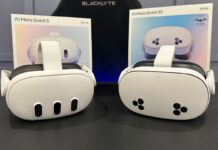
Play games, watch shows and movies, surf the web, and much more in virtual reality from absolutely anywhere. The Oculus Quest 2 is an all-in-one wireless VR headset that doesn’t require any additional equipment. There’s no need to connect to a console or expensive gaming PC, nor are there any necessary cables, wires, or sensors to hook up. Simply slide your Oculus Quest 2 headset on and enter an amazing world of VR.
Oculus Quest 2 pushes the boundaries of VR comfort and accessibility
As an early adopter of VR headsets, I can’t believe how fast the technology is advancing. I recall my first experiences just a few short years ago. They were underwhelming affairs featuring cumbersome, uncomfortable headsets with bulky cables and unimpressive sensors.
I can see now that the Oculus Quest 2 is exactly the kind of VR headset I was wishing for at the beginning. This headset is lightweight, minimal, and, most importantly, comfortable, yet it still performs great. It took a few years, but the Oculus Quest 2 shows how we are pushing past the initial bumps and roadblocks of affordable and functional virtual reality and toward a bright future.
The Quest 2 features 1832 x 1920 pixels per eye, and a 72Hz refresh rate (with the option to bump up to 90Hz currently in beta). These aren’t the most high-end VR specs available. However, they are amazing when you consider the standalone nature of the headset. Furthermore, the whole package is incredible when you take into consideration the price range of the Oculus Quest 2 over more expensive VR rigs.
The only real downside in my opinion is the mandatory Facebook login the Quest 2 requires. Personally, I’m not a Facebook guy. Having to make a dummy Facebook account to use this VR headset bothers me more than a little. I wish there were a separate option, but sadly the two products are forever tied together.

Take VR with you anywhere you go
The most important feature of the Oculus Quest 2 is the fact that it’s a completely standalone product. There’s no PC or console necessary. The Quest 2 is its own gaming and entertainment hub. As Dr. Seuss might say, “You can play it here or there, you can play it anywhere”!
Since the Quest 2 works all on its own, it obviously requires onboard storage for games and apps. There are two different options here: a 64 GB model and a 256 GB model. Most games available come in around 2 – 6 GB, although some larger games (such as the recent Walking Dead: Saints and Sinners) can approach 12 GB or more in size.
This should mean that the smaller 64 GB model will be sufficient for most. It’s possible to download a healthy amount of content with this much space, especially if you tend to delete older games over time. However, if you intend to build a massive library that you always want available, the 256 GB model may be the choice for you.

Easy setup in a play area of any size
The Oculus Quest 2 is far and away among the easiest VR headsets to get up and running. Getting started is as simple as sliding the headset on and establishing your play area. Since the headset uses its own built-in cameras (instead of sensors), video passthrough allows you to see your surroundings even with the headset on.
There are essentially 3 ways to play—sitting, standing, or roomscale. When you enter VR with the Quest 2, you’ll essentially decide how you want to play, and the headset will assist you in creating a boundary. You’ll then receive a visual warning anytime you are in danger of exceeding the boundary, making it easy to maintain your space and not wander or bump into your surroundings.

The really amazing thing is that the Quest 2 will actually allow you to create a custom boundary. Instead of estimating the room or choosing from preset sizes, you can simply use the controller in passthrough mode to draw your own boundary on the floor. You’ll instantly have a play area that perfectly matches the room you are playing in.
The boundary system works so well and perfectly suits the portable functionality of the Quest 2. If you are sitting down, you can shift to a stationary boundary as well. Some games and apps are primarily designed for sitting, while others require roomscale movement. Check the details of any given app to see which modes it supports.

PC VR functionality via Oculus Link
While the Oculus Quest 2 functions on its own, it’s still possible to expand its use to a PC. This requires utilizing “Oculus Link”, which involves installing the Oculus App and connecting to your PC via the Oculus Link Cable (or a similar high-speed USB-C cable). Using this method, Quest 2 owners can access the Oculus Rift library in tandem with a VR-ready PC.
This is definitely important to me as I want to be able to play games from my Steam library with the Quest 2. Luckily, this is very much possible by connecting the headset to the Oculus PC App via Oculus Link and then downloading the “Steam VR” App from the Oculus Rift store.
Unfortunately, I do not have the official Oculus Link Cable for testing, but I was able to get up and running using the USB-C cable from my Nintendo Switch console. With little effort, I was soon playing Star Wars: Squadrons in VR via Steam. You can read more about the Star Wars VR experience in my Star Wars: Squadrons review!

Preparation for Oculus Link
While my Switch cable works well enough, I did encounter a bit of lag here and there. If you intend to use the Oculus Link feature regularly, I recommend either investing in the official cable (warning—it’s not inexpensive), or researching to ensure you obtain a third-party cable that meets the high-speed requirement.
Another aspect I noticed was that the built-in headphones weren’t quite loud enough in many instances when using Oculus Link—even at max volume. This was a quick fix, however, since the Quest 2 also supports external headphones via a 3.5mm headphone jack.
After plugging in my Beats Over-Ear Headphones (which fit comfortably over the Quest 2’s sleek design), the sound experience improved greatly, and I realized that this was my preferred audio solution overall—not just when necessary to bolster the weaker volume in link mode.

The Oculus Link 2 is one of the most accessible and streamlined VR options out there
As previously stated, my first impressions of VR were less than stellar. So much so that I haven’t given the technology much attention since those earliest days. However, the Oculus Quest 2 clearly demonstrates for me that VR is finally delivering the experience I was hoping for in the beginning.
The Quest 2 is so easy to use. It fits comfortably, offers a decent library of games and apps, and best of all it’s extremely portable. I love the fact that it delivers awesome VR anywhere without the need for a console, PC, or sensors. Not to mention that owners get all this at a much lower cost than that of high-end VR rigs.
I could do without the mandatory Facebook integration. However, I’m ultimately willing to curate a dummy account in order to enjoy the Quest 2 on its own, as well as in conjunction with my PC via Oculus Link. The Oculus Quest 2 is a fantastic choice for VR enthusiasts, casual users, and newcomers alike.
Oculus Quest 2 64GB VR Headset with Touch Controllers
Oculus Quest 2 256GB VR Headset with Touch Controllers




I have tried a few types of VR systems and I love hearing that this is lightweight! That’s a very important feature for me because you move around and with lots of pressure on your neck/shoulders/head it might not be as enjoyable as you would like!
Comments are closed.